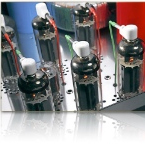Retained
-
Member Title
Intellectually Curious Member
Personal Information
-
Location
Bay Area, CA
Recent Profile Visitors
12282 profile views
-

Article: Let 1,000 Frequency Responses Bloom
sdolezalek replied to Josh Mound's topic in Article Comments
To get to this conclusion, need we assume that we all hear alike? What if we not only each have different musical tastes, but we actually hear and perceive sounds differently? If the artist, the recording master and the audience all hear the same way then that "standard" becomes very important. But what about the 36% that doesn't prefer the Harman curve? Are they "wrong" or do they hear differently? What I like about the data that underlies the music is that we can agree whether or not what was played live matches what was recorded and then played back (making a huge assumption that we can and do measure what matters). A flat frequency response is only one such measurement. There are live venues I like and others I don't. Is one venue more correct or better than another? Maybe, if 100% of audiences agreed with me, but I know they don't. This is one of the reason's I have been so pleased with the various choices offered by software like HQ Player, rather than the choices of one DAC designer/engineer. It allows me to make what I hear in my listening room sound as much as I can make it, sound like what I hear with live instruments and voices. Doing that is a function not only of the recording, but certainly also of my playback chain, and the audio characteristics of my listening room. A music studio can really only address the first of these three. The other two are a function of budget, equipment choices, and room choices and how each of those alters the original AND my particular sensitivities to anomalies (in frequency, in reverb, in wave form, etc.) Thus, to me I don't want some majority view of what sounds best -- I just want my output file to look as identical as possible to the original... Your ears may vary ;-) -
It does, but only for Sublime subscribers. Interestingly, although they claim that Studio level subscribers have access to all the hi-res content for streaming only (not purchase) this is an example where you can't stream the 24/192 version (only the 16/44 version). As advertised the two tiers never made sense to me: Why should you pay more each month for the privilege to buy what you can already stream (presumably they want to encourage as many purchases as possible). But if they are also limiting the streaming quality then they aren't living up to their sales representations, which say that Studio level gets full access to 24/192 and 24/96 files for streaming..
-

Article: Is It Time To Rethink Lossless?
sdolezalek replied to The Computer Audiophile's topic in Article Comments
These days we can always use AI to fill in the missing information! -
This is a nuance I hadn't picked up on earlier. If you start with Intel's Core i9 13900K 3.0GHz 24 Core 36MB, then just how fast does the GPU need to be to be helpful? Is the NVIDIA GeForce RTX 4080 16GB Open Air fast enogh, or would I need to go to the 4090 at more than 16GB to benefit?
-

Building the ultimate Roon core / HQPlayer (for upsampling)
sdolezalek replied to dusk's topic in Music Servers
I have bought my systems from Puget Systems as well and they have always done a nice job. I'm curious why you wen with AMD instead of Intel specifically for HQ Player? I'm thinking of a new i9/4090 combination but for a desktop solution that then feeds my NAA. -
Does anyone have any experience using MoCA 2.5 Network adaptors for 2.5Gb Internet, Ethernet Over Coax? I'm specifically interested in the degree to which this is liklely to transmit additional noise into my data stream (yes, I understand electrical noise can't change digital bits,,,). I would use this only for Ethernet and not run other signals (i.e. video) through this line, but video would run on a second coax cable that travels a similar in-wall path. My current in-wall Ethernet cabling is Cat5e and I'd like to get greater throughput, but not at the expense of adding noise.
-
Great experience and great article! But your comments on the sound coming out of the Sennheiser headphones seems to just be begging for answers to questions I didn't see above: 1) how much of that quality is lost in the mixing process; 2) how much is lost through the recording format/process; and c) where else does the degradation result from the stream you were hearing?
-
Puget has built my prior systems and does really good work, but I have tried for the last several years to get them to build an HQPlayer specific machine (the way they do for other software packages), but they haven't felt enough demand and don't really know enough about the specific needs for HQPlayer to make strong recommenbdations.
-
That only proves that “Just because can’t or don’t measure something, is not particularly relevant to whether or not it matters.” Which is the other half of: “Just because you can hear a difference, doesn’t mean you can easily find what you need to measure to explain the difference.”
-
Just too funny - it never occurred to me that the default volume setting in 5.0 would be zero. But YES that was the problem. After turning the volume up everything works great. Thank you!
-
Help please: No audio from HQPlayer 5.0 Everything seems to be right in that my Holo Audio May is clearly seeing any changes I make in HQPlayer in terms of 256 vs 512, and HQPlayer shows as playing on my iPad with the correct settings, and I have swirched from the new modulators back to my HQP 4 settings and those changes show up, but still no sound??? I have rebooted my power supply, my UltraRendu, my DAC, my PreAmp, etc. I uninstalled HQP 4 after (but not before installing HGP 5. I did re-enable Network Control. Roon does see HQPlayer and shows the correct settings on playback. Similarly HQP sees the UltraRendu and the May Dac as its output devices. But still no sound... Playback chain is Roon and HQP5 on main PC, then to UltraRendu (as NAA: note software update on UltraRendu does not update HQP NAA software to latest version) then via USB to May Dac Any ideas?
-
For a new build today, I'm curious what those who are deep in this thread would change about the following configuration: Intel Core i9 13,900DK Asus ProArt Z790 ATX motherboard 128GB DDR5 Kingston RAM NVIDIA RTX4070Ti 12GB 2TB Sabrent Rocket 4 Plus SSD Noctua NH-U12A (Intel 115x and AMD AM4) To be used with HQPlayer to feed Holo Audio May KTE through UltraRendu Thanks!
-
Actually, I liked this one quite a bit. 😀 Thanks I completely agree that bigger isn't necessarily better -- we had the same thing in the mexapixel race in digital cameras; often adding lots of pixels also just adds lots of noise (which then has to be cleaned up in software). Until recently, it was easier with consumer sized sensors just to go with fewer pixels and cleaner images. But technology has moved on and my 50 Megapixel R5 is as clean or cleaner than my 1Ds from 5 years ago. I also agree that we often don't know what to measure or whether it matters, I learned that in trying to build speakers with very low harmonic distortion (until we realized) that none of our customers could tell the difference -- we wanted .0001% in amplifiers but 10-20% was just fine in speakers, I still don't know why. I also know that with my May KTE DAC there are HQ Player settings that sound great for an hour or two but wear on me after a few days, the ones that seem really good even after a few weeks of listening are often not ones that stand out when doing instant comparisons...






